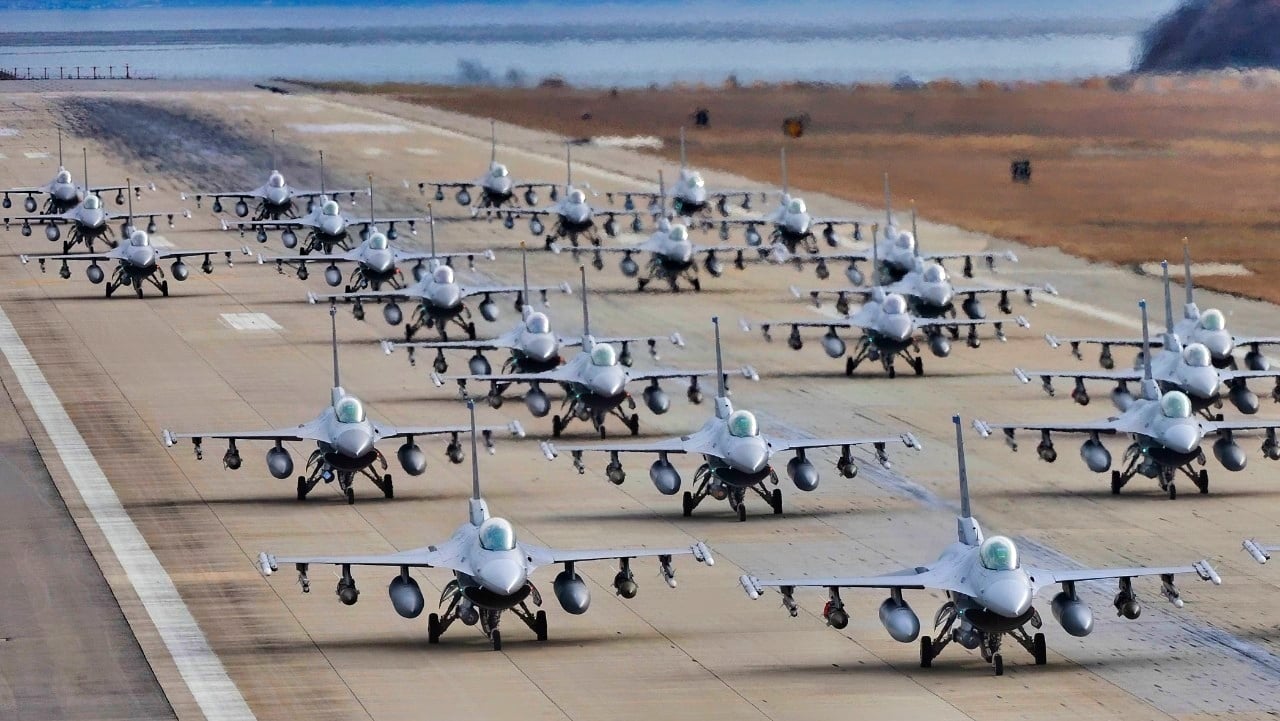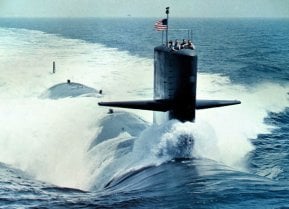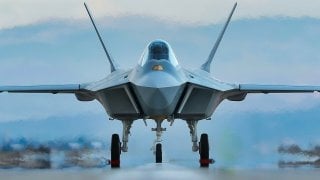TAI TF Kaan: Turkey's New Stealth Fighter Is Born
Turkey is developing its own fifth-generation stealth fighter, the TAI Kaan (also known as TF or MMU), aiming to rival advanced aircraft like the F-35.
What You Need to Know: Turkey is developing its own fifth-generation stealth fighter, the TAI Kaan (also known as TF or MMU), aiming to rival advanced aircraft like the F-35.

-The Kaan made its maiden flight in February 2024 and is intended to replace Turkey's F-16 fleet. Powered by two General Electric F110-GE129 engines, it boasts advanced stealth features, a top speed of Mach 1.8, and multirole capabilities including air superiority and ground attack. Despite successful test flights, comparisons to established fighters like the F-35 invite skepticism.
Problems: Recent terrorist attacks at TAI's headquarters in Ankara have raised concerns about potential delays in the Kaan's development.
When one thinks of countries producing fifth-generation stealth fighters, chances are one thinks of the Big Three (to use an American automotive manufacturing analogy): the United States of America, e.g., the Lockheed Martin F-22 Raptor and F-35 Lightning II; Russia, e.g., the Sukhoi Su-57 (NATO reporting name “Felon”) and Su-75 “Checkmate”; and China, e.g., the Chengdu J-20 Weilong (“Mighty Dragon”; NATO reporting name “Fagin”).
What’s sometimes lost in the shuffle is the fact there’s a fourth country in the act of producing a stealth fighter, a country that’s ostensibly a NATO member nation and U.S. ally, but has been getting awfully cozy with Russia (and to a lesser extent, China) lately: Turkey. Say “Merhaba (Hello)” to the Turkish Aerospace Industries (TAI; Turkish language acronym TUSAS) Kaan (“Leader” or “Ruler”), AKA the TF (“Turkish Fighter”) and MMU (Milli Muharip Ucak; “National Combat Aircraft”).
TAI Kaan Initial History & Specifications
The TAI Kaan made its maiden flight on February 21, 2024. Prior to this, the prototype had conducted taxi and ground tests on March 16, 2023, followed by a ceremonial unveiling two days later. The Kaan is intended to replace the Turkish Air Force’s American-made F-16 Fighting Falcon (AKA “Viper”) fleet, and is also intended for foreign military sales (FMS).

A major driving force behind Turkey’s decision to pursue a homegrown stealth fighter has been the recent decline in Turkey-U.S. relations, particularly Washington’s refusal to sell Patriot missile batteries to Ankara, and booting the Turks out of the F-35 FMS customer list in 2019.
The Kaan reportedly has the following preliminary specifications and vital stats:
Fuselage Length: 68 ft 11 in (21 m)
Wingspan: 45 ft 11 in (14 m)
Height: 19 ft 8 in (6 m)
Max Takeoff Weight: 60,000 lb (27,215 kg) takeoff, 51,320 lb (23,280 kg) combat weight
Powerplant: 2 x General Electric F110-GE129 engines with 58,000 lb (26,308 kg) of thrust (NOTE: This is the same engine powering the F-15EX Eagle II)
Max Airspeed: Mach 1.8 (1,381 mph; 2,222 km/h)
Service Ceiling: 55,000 ft (16,764 m)
g-Limits: +9.0 and -3.5
My colleague Brandon J. Weichert adds in a July 1, 2024, article for The National Interest:
“Turkey’s TF Kaan boasts advanced stealth capabilities, making it difficult to detect by radar, infrared, and other sensors. It is equipped with advanced avionics, including a fly-by-wire system, active electronically scanned array radar, and an electronic warfare (EW) suite…This warbird can carry a variety of weapons, including air-to-air weapons, air-to-ground missiles, and guided bombs. It is also equipped with a 20mm cannon for close air support missions. “
The plane is envisioned as being multirole (air superiority missions, ground attack, and reconnaissance alike).
Operational Performance
That aforementioned maiden flight of the MMU was a fairly modest performance, lasting just thirteen minutes, with the aircraft reportedly reaching an altitude of 8,000 ft (2,438.4 m) and a speed of 230 kts (254 mph; 425.9 km/h). A second test flight was carried out this past May, whereupon the manufacturer’s in-house test pilot took the prototype up to 10,000 feet (3,048 m) for more than fourteen minutes.
This second mission prompted a rather bold claim by TUSAS General Manager Temel Kotil (as quoted by Joe Saballa of The Defense Post):
“This aircraft is better than the F-35…The F-35 carries six tons, [the KAAN] carries 10 tons of ammunition... Having two engines means more energy and radars illuminating a greater distance."
Kotil’s comments must of course be taken with a grain of salt, as the Kaan is still in the prototype phase and isn’t expected to go operational until sometime in the 2030s, whilst the F-35 has been in production since 2006 and has indeed already been proven in combat (thanks to the Israeli Air Force). Meanwhile, one of the delicious ironies of that second Kaan test fight is the fact that a Turkish Air Force F-16 acted as a safety/chase plane!
The Way Forward
As I type these words, by eerie coincidence, we have just received news that TAI’s headquarters in Ankara’s Kahramankazan district has been subjected to a terrorist attack, with reports of an explosion followed by gunshots. Details are still sketchy at this point, but there have been an unspecified number of deaths, with Turkish interior minister Ali Yerlikaya stating on X (formerly Twitter) that “Unfortunately, we have martyrs and injured people,” Meanwhile, Turkey’s state-run Anadolu news agency stated that the nation’s security forces are in the process of neutralizing “terrorists.”
Besides the human tragedy of the lives lost in this attack, it remains to be seen how this attack on the TAI/TUSAS HQ will impact the development and production schedule of not only the Kaan but the company’s Anka-3 UCAV (no relation to Canadian-American singer Paul Anka).
In the meantime, to quote Weichert one more time:
“As for the reactions of foreigners, well, they have been mixed so far. While some countries have expressed interest in acquiring the aircraft, others, such as Greece and Cyprus, have raised concerns about the potential impact on regional security. This is not surprising, considering the aforementioned tensions among those sides. Indeed, it risks completely collapsing NATO’s vaunted southern defense perimeter, as Athens and Ankara bicker over everything from territorial rights to whose culture is superior…Thus, the TF KAAN-F-35 debate rages within this nasty context…Turkey has broken with the United States. The creation of an indigenous fifth-generation warbird to rival the F-35 is just the inevitable, ultimate end of this shift.”
About the Author:
Christian D. Orr is a Senior Defense Editor for National Security Journal (NSJ). He is a former Air Force Security Forces officer, Federal law enforcement officer, and private military contractor (with assignments worked in Iraq, the United Arab Emirates, Kosovo, Japan, Germany, and the Pentagon). Chris holds a B.A. in International Relations from the University of Southern California (USC) and an M.A. in Intelligence Studies (concentration in Terrorism Studies) from American Military University (AMU). He has also been published in The Daily Torch, The Journal of Intelligence and Cyber Security, and Simple Flying. Last but not least, he is a Companion of the Order of the Naval Order of the United States (NOUS).
Image Credit: Creative Commons.


